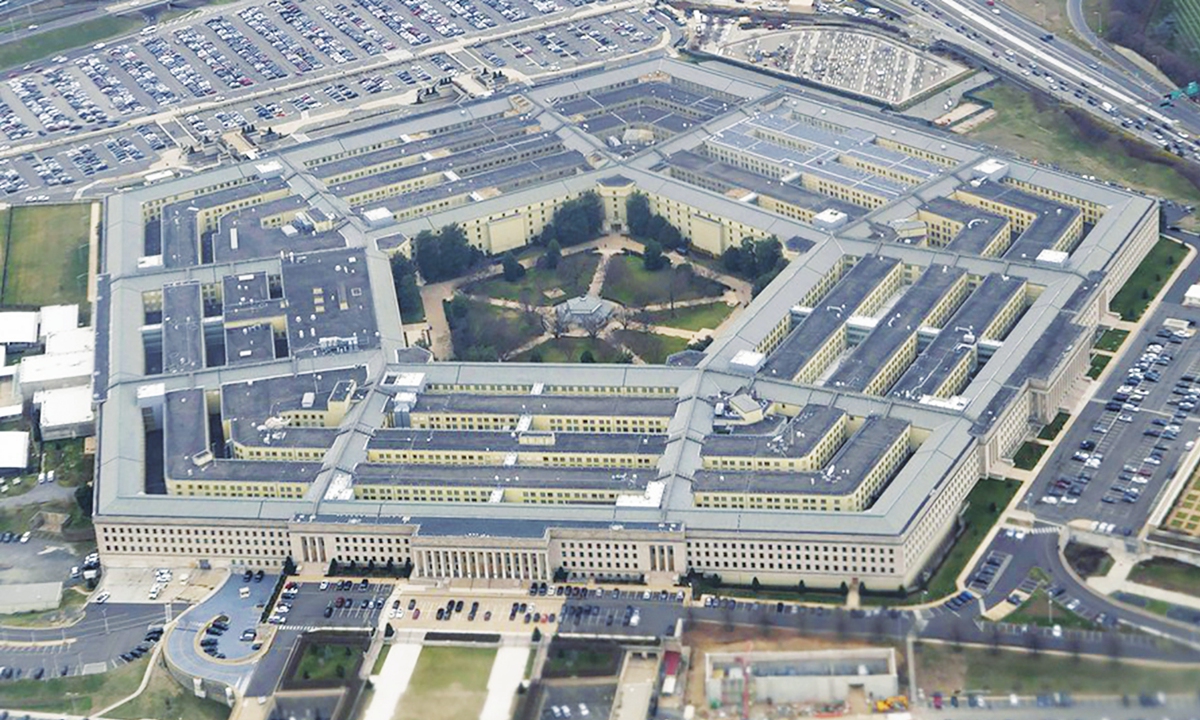
The Pentagon seen from an airplane over Washington DC. Photo: Xinhua
The US Air Force is reportedly preparing to restructure itself on a scale unseen in decades, part of Washington's wider efforts to confront and contain the rise of China.In an article entitled "Air Force preps for mega overhaul with an eye toward China," Politico explained plans to streamline US Air Force bureaucracy, accelerate "new uncrewed aircraft and fighter plane projects," and reorganize US Air Force units. All of these measures are aimed at developing capabilities to outmatch China, the report said.
This process of reorganizing is already underway in other branches of the US military. In 2020 the US Marine Corps began divesting tanks and reducing cannon artillery in favor of longer-range missiles, meant specifically to fight China across the Indo-Pacific.
Politico does not articulate the threat the US believes China poses motivating Washington to undertake such radical changes. Across US foreign policy circles, the threat China allegedly poses to the US is often taken for granted, referred to simply as the "pacing threat."
During a January 2024 CSIS event titled "Air Force Priorities in an Era of Strategic Competition," US Air Force Lieutenant General Richard Moore said: "We do not want that war. We do not want war with China and war with China is not inevitable. But if provoked and drawn into that war, we intend to win and that's what this is all about. But there's nothing inevitable about this conflict. It does not have to occur and it will not occur by our choice."
Yet, throughout the same event, participants noted the US Air Force's challenge of moving massive amounts of American military power into the Indo-Pacific, thousands of miles from American shores, along and even within Chinese borders to prepare for and win a war against China.
The US has a massive military presence across Asia with tens of thousands of troops stationed in South Korea and Japan. There is also a growing military presence in the Philippines. The US is militarizing these nations and has made it clear they will be recruited into a US-led coalition should war break out between China and the US.
Despite the US officially has its one-China policy, the US has armed the Taiwan region and has even placed US troops on the island itself.
General Moore's statement that the US doesn't want war, despite its actions provoking one, is essentially indicating that if war is to be avoided, China should simply accept American domination.
Not only are these US ambitions unacceptable, but they are also unrealistic, including the US Air Force's plans to reorganize its forces in preparation for a potential war with China.
One of the key components of the future US Air Force is the development of uncrewed aircraft through the collaborative combat aircraft or "loyal wingman" program. It envisions the creation of "affordable mass" for its forces by combining cheaper and a larger quantity of unmanned aerial vehicles (UAV) alongside manned warplanes. This is meant to offset China's advantage in both manpower and manufacturing.
The fatal flaw of this premise is assuming that China doesn't have the ability to outproduce and outnumber the US in terms of both crewed and uncrewed aircraft. China is in fact already developing its own loyal wingman UAV.
Another aspect of US Air Force reorganization is the creation of "composite wings" and the shifting to its "Agile Combat Employment" (ACE) strategy of distributing these wings across a greater number of bases in the Indo-Pacific. This is meant to offset China's advantage in long-range precision missiles and its ability to target and destroy US bases in the region.
The ACE strategy aims to relocate US airpower between bases, making it harder for China to locate and target US assets and predict the origin of an American attack.
This approach is similar to the distributed maneuver tactic employed by US-trained Ukrainian forces against the superior firepower of Russian forces. The idea was that by dispersing larger numbers of Ukrainian troops into smaller, independent units, it would be challenging for Russia to concentrate firepower on them.
However, in reality, Russian forces not only possessed superior firepower, but also outnumbered the Ukrainian troops, nullifying any advantage the distributed maneuver strategy may have provided.
Similarly, for US Air Force units distributed across the Indo-Pacific region using the ACE strategy, they will face not only China's superior missile capabilities, but also superior numbers of Chinese warplanes as well as advanced integrated air defense networks.
In simpler terms, the US is attempting to achieve the impossible. It is a nation with a smaller population, a smaller industrial base, and soon, a smaller economy. Chinese forces are growing in terms of both quantity and quality.
The US is blinded by a deeply embedded belief in its own inherent superiority, preventing it from objectively assessing the prospect of war with China, not only in terms of how the war will be fought, but also whether or not it should be fought at all.
Washington is aware of the many and multiplying advantages China has, leading to the attempt at urgently reorganizing America's military forces. However, when comparing the balance of US and Chinese power, the US seems to automatically add "inherent supremacy" to its column and neglect its disadvantages. What it prepares for is one of the most senseless and avoidable potential wars in human history.
The author is a geopolitical analyst and a veteran of US Marine Corps. opinion@globaltimes.com.cn
